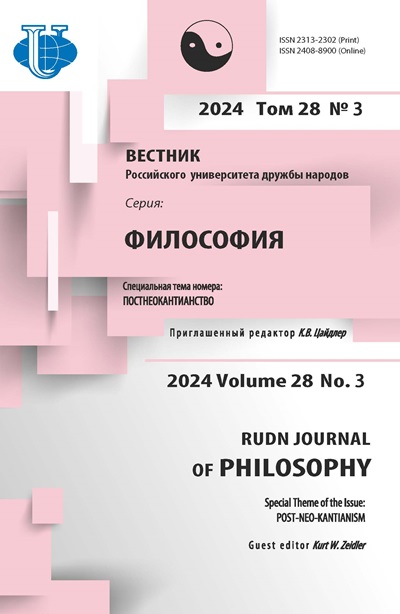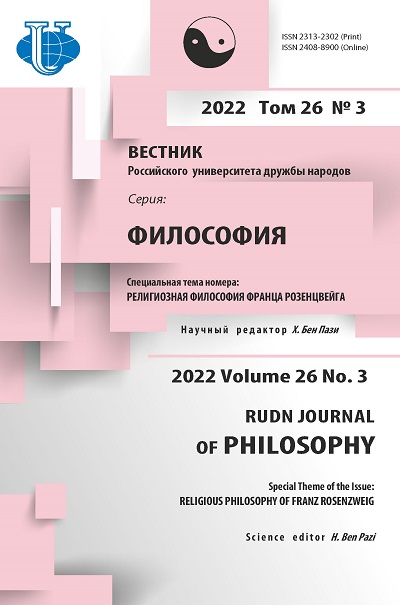Запрет идолопоклонства и концепция различия в философии Франца Розенцвейга
- Авторы: Пигалев А.И.1
-
Учреждения:
- Волгоградский государственный университет
- Выпуск: Том 26, № 3 (2022): РЕЛИГИОЗНАЯ ФИЛОСОФИЯ ФРАНЦА РОЗЕНЦВЕЙГА
- Страницы: 509-522
- Раздел: РЕЛИГИОЗНАЯ ФИЛОСОФИЯ ФРАНЦА РОЗЕНЦВЕЙГА
- URL: https://journals.rudn.ru/philosophy/article/view/32103
- DOI: https://doi.org/10.22363/2313-2302-2022-26-3-509-522
Цитировать
Полный текст
Аннотация
Целью исследования является анализ контекста, сущности и философских следствий переосмысления Францем Розенцвейгом запрета идолопоклонства в качестве следствия строгого монотеизма. Чаще всего идолопоклонство в общем смысле определяется как поклонение некоторым образам (идолам), которые, будучи почитаемыми объектами, считаются представляющими дух или божество. Исследование ограничивается анализом значения запрета идолопоклонства для интерпретации Розенцвейгом концепции различия, лежащего в основе его теоретической модели Другого. Рассмотрение исходит из общего предположения, что соприкосновение традиции с модерном является фактором, определяющим радикальные изменения в философии модернизирующихся обществ. В этом контексте древний запрет идолопоклонства означает отклонение и запрет любых репрезентаций в качестве форм сложного опосредования, которое, в свою очередь, является отличительным признаком модерна. Однако, согласно Розенцвейгу, идолопоклонство представляет собой не использование образов в качестве репрезентаций Бога, считающегося нерепрезентируемым, а фиксацию на одном образе, что означало бы произвольное ограничение бесконечной свободы Бога открывать себя визуально. Отсюда следует, что переосмысленный запрет идолопоклонства не требует полного запрета репрезентации, но она должна быть понята в качестве ограниченной во времени. Такой подход не допускает отождествления репрезентации некоторого объекта с ним самим, знака с вещью, и поэтому в его рамках запрещается самореференциальность. Позиция Розенцвейга определяет также его понимание привычности, непривычности и различия в искусстве и переводе. Акценту Розенцвейга на очень сильном воздействии различия, вызывающего чувство непривычности и чуждости и являющегося характерной чертой произведения искусства, соответствует его понимание перевода, который должен сделать устойчивые общепринятые смыслы непривычными. Таким образом, переосмысленный запрет идолопоклонства лежит в основе концепции Розенцвейга сочетания еврейской традиции и модерна.
Ключевые слова
Об авторах
Александр И. Пигалев
Волгоградский государственный университет
Автор, ответственный за переписку.
Email: pigalev@volsu.ru
ORCID iD: 0000-0003-4858-8862
доктор философских наук, профессор, ведущий научный сотрудник кафедры философии и теории права
Российская Федерация, 400062, Волгоград, Университетский проспект, д. 100Список литературы
- Rosenzweig F. Das neue Denken. Einige nachträgliche Bemerkungen zum “Stern der Erlösung”. In: Der Mensch und sein Werk. Gesammelte Schriften. Bd. 3. Zweistromland: Kleinere Schriften zu Glauben und Denken. Hrsg. von R. Mayer und A. Mayer. Dordrecht, et al.: Martinus Nijhoff; 1984. s. 139-161.
- Halbertal M., Margalit A. Idolatry. Goldblum N (tr.). Cambridge (MA), London: Harvard University Press; 1992.
- Strauss LB, Brenner M, editors. Mediating Modernity: Challenges and Trends in the Jewish Encounter with the Modern World: Essays in Honor of Michael A. Meyer. Detroit (MI): Wayne Stae University Press; 2008.
- Meyer MA, Myers DN, editors. Between Jewish Tradition and Modernity: Rethinking an Old Opposition: Essays in Honor of David Ellenson. Detroit (MI): Wayne State University Press; 2014.
- Löwy M, Sayre R. Romanticism Against the Tide of Modernity. Porter C (tr.). Durham; London: Duke University Press; 2001.
- Rubinstein E. An Episode of Jewish Romanticism: Franz Rosenzweig’s The Star of Redemption. Albany (NY): SUNY Press; 1999.
- Benjamin MH. Rosenzweig’s Bible: Reinventing Scripture for Jewish Modernity. Cambridge (UK), et. al.: Cambridge University Press; 2009.
- Akush A. Moses Mendelssohn and the Enlightenment. Albany (NY): SUNY Press; 1994.
- Freudenthal G. No Religion without Idolatry: Mendelssohn’s Jewish Enlightenment. Notre Dame (IN): University of Notre Dame Press; 2012.
- Rosenzweig F. Zur Encyclopaedia Judaica. Zum zweiten Band. Mit einer Anmerkung über Antropomorphismus. In: Der Mensch und sein Werk. Gesammelte Schriften. Bd. 3. Zweistromland: Kleinere Schriften zu Glauben und Denken. Hrsg. von R. Mayer und A. Mayer. Dordrecht, et al.: Martinus Nijhoff; 1984. s. 735-741.
- Batnitzky L. Idolatry and Representation: The Philosophy of Franz Rosenzweig Reconsidered. Princeton (NJ): Princeton University Press; 2000.
- Rosenzweig F. The Star of Redemption. Galli BE (tr.). Madison (WI): The University of Wisconsin Press; 2005.
- Heidegger M. The Origin of the Work of Art. In: Off the Beaten Track. Young J and Haynes K, editors and tr. Cambridge (UK): Cambridge University Press; 2002. p. 1-56.
- Rosenzweig F. Die Schrift und Luther. In: Der Mensch und sein Werk. Gesammelte Schriften. Bd. 3. Zweistromland: Kleinere Schriften zu Glauben und Denken. Hrsg. von R. Mayer und A. Mayer. Dordrecht, et al.: Martinus Nijhoff; 1984. s. 749-772.
- Rosenzweig F. Neues Lernen. In: Der Mensch und sein Werk. Gesammelte Schriften. Bd. 3. Zweistromland: Kleinere Schriften zu Glauben und Denken. Hrsg. von R. Mayer und A. Mayer. Dordrecht et al.: Martinus Nijhoff; 1984. s. 505-510.
















